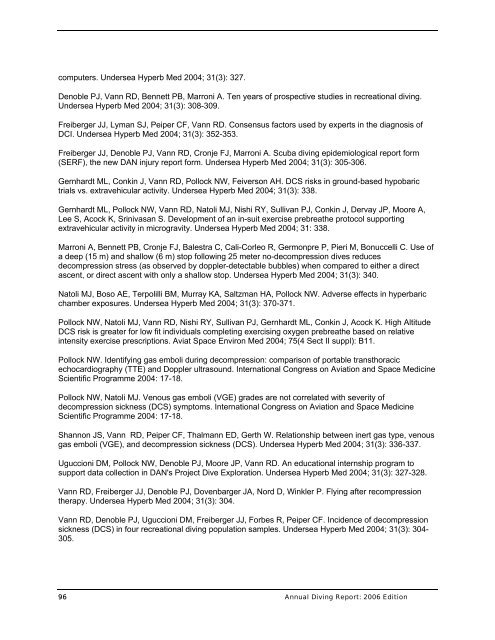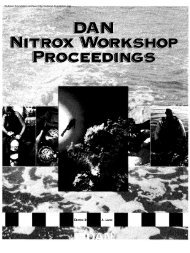Annual Diving Report - Divers Alert Network
Annual Diving Report - Divers Alert Network
Annual Diving Report - Divers Alert Network
Create successful ePaper yourself
Turn your PDF publications into a flip-book with our unique Google optimized e-Paper software.
computers. Undersea Hyperb Med 2004; 31(3): 327.<br />
Denoble PJ, Vann RD, Bennett PB, Marroni A. Ten years of prospective studies in recreational diving.<br />
Undersea Hyperb Med 2004; 31(3): 308-309.<br />
Freiberger JJ, Lyman SJ, Peiper CF, Vann RD. Consensus factors used by experts in the diagnosis of<br />
DCI. Undersea Hyperb Med 2004; 31(3): 352-353.<br />
Freiberger JJ, Denoble PJ, Vann RD, Cronje FJ, Marroni A. Scuba diving epidemiological report form<br />
(SERF), the new DAN injury report form. Undersea Hyperb Med 2004; 31(3): 305-306.<br />
Gernhardt ML, Conkin J, Vann RD, Pollock NW, Feiverson AH. DCS risks in ground-based hypobaric<br />
trials vs. extravehicular activity. Undersea Hyperb Med 2004; 31(3): 338.<br />
Gernhardt ML, Pollock NW, Vann RD, Natoli MJ, Nishi RY, Sullivan PJ, Conkin J, Dervay JP, Moore A,<br />
Lee S, Acock K, Srinivasan S. Development of an in-suit exercise prebreathe protocol supporting<br />
extravehicular activity in microgravity. Undersea Hyperb Med 2004; 31: 338.<br />
Marroni A, Bennett PB, Cronje FJ, Balestra C, Cali-Corleo R, Germonpre P, Pieri M, Bonuccelli C. Use of<br />
a deep (15 m) and shallow (6 m) stop following 25 meter no-decompression dives reduces<br />
decompression stress (as observed by doppler-detectable bubbles) when compared to either a direct<br />
ascent, or direct ascent with only a shallow stop. Undersea Hyperb Med 2004; 31(3): 340.<br />
Natoli MJ, Boso AE, Terpolilli BM, Murray KA, Saltzman HA, Pollock NW. Adverse effects in hyperbaric<br />
chamber exposures. Undersea Hyperb Med 2004; 31(3): 370-371.<br />
Pollock NW, Natoli MJ, Vann RD, Nishi RY, Sullivan PJ, Gernhardt ML, Conkin J, Acock K. High Altitude<br />
DCS risk is greater for low fit individuals completing exercising oxygen prebreathe based on relative<br />
intensity exercise prescriptions. Aviat Space Environ Med 2004; 75(4 Sect II suppl): B11.<br />
Pollock NW. Identifying gas emboli during decompression: comparison of portable transthoracic<br />
echocardiography (TTE) and Doppler ultrasound. International Congress on Aviation and Space Medicine<br />
Scientific Programme 2004: 17-18.<br />
Pollock NW, Natoli MJ. Venous gas emboli (VGE) grades are not correlated with severity of<br />
decompression sickness (DCS) symptoms. International Congress on Aviation and Space Medicine<br />
Scientific Programme 2004: 17-18.<br />
Shannon JS, Vann RD, Peiper CF, Thalmann ED, Gerth W. Relationship between inert gas type, venous<br />
gas emboli (VGE), and decompression sickness (DCS). Undersea Hyperb Med 2004; 31(3): 336-337.<br />
Uguccioni DM, Pollock NW, Denoble PJ, Moore JP, Vann RD. An educational internship program to<br />
support data collection in DAN's Project Dive Exploration. Undersea Hyperb Med 2004; 31(3): 327-328.<br />
Vann RD, Freiberger JJ, Denoble PJ, Dovenbarger JA, Nord D, Winkler P. Flying after recompression<br />
therapy. Undersea Hyperb Med 2004; 31(3): 304.<br />
Vann RD, Denoble PJ, Uguccioni DM, Freiberger JJ, Forbes R, Peiper CF. Incidence of decompression<br />
sickness (DCS) in four recreational diving population samples. Undersea Hyperb Med 2004; 31(3): 304-<br />
305.<br />
96 <strong>Annual</strong> <strong>Diving</strong> <strong>Report</strong>: 2006 Edition

















